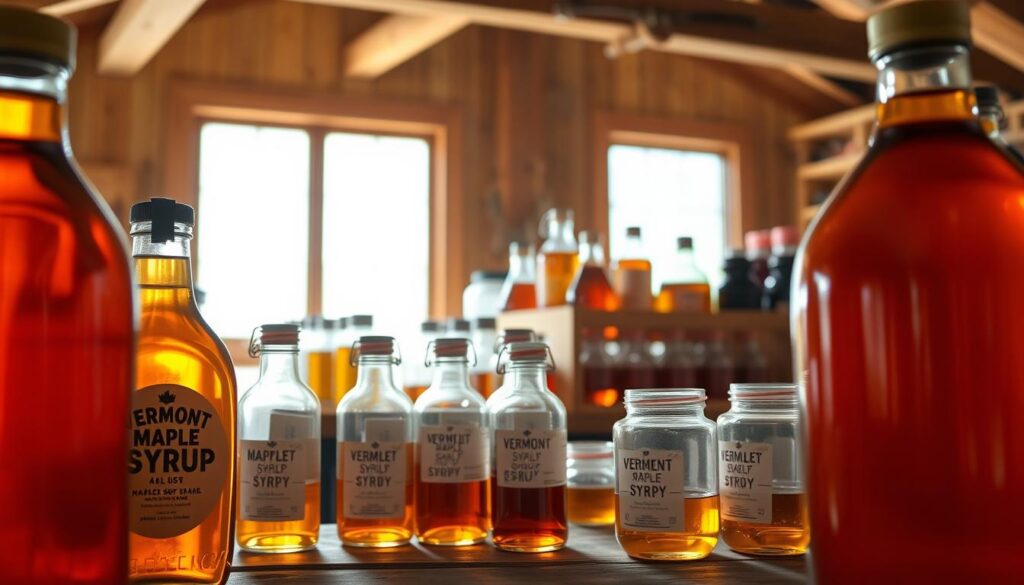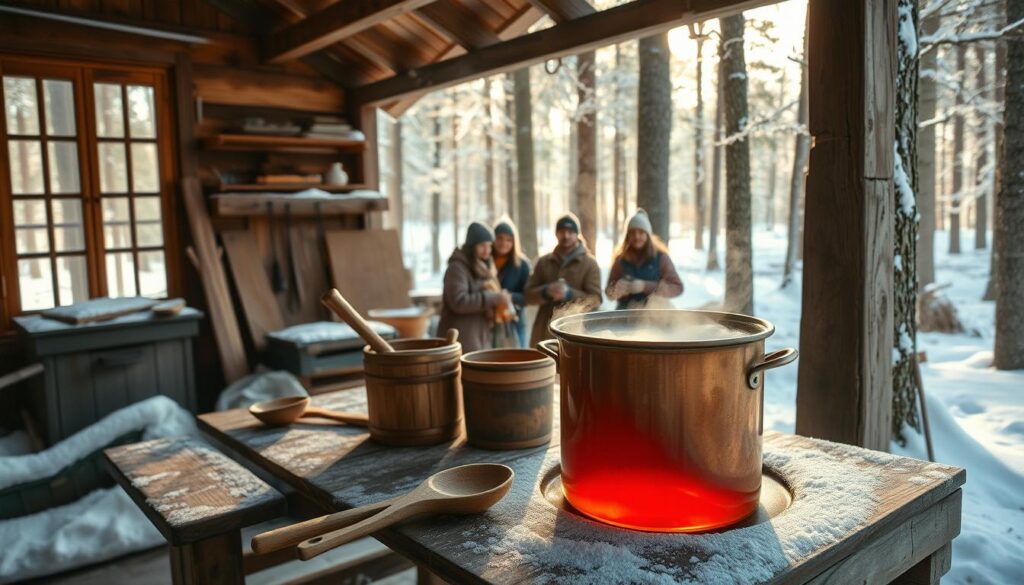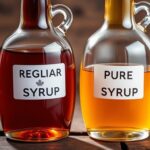Maple syrup production is a tradition that turns tree sap into gold. Every spring, sugarmakers in North America start the Maple Syrup Boil. This process needs skill, patience, and knowing nature’s rhythms.
The magic starts in the forest, where maple trees store sap in winter. When it gets cold at night and warm during the day, the trees release their sap. The Maple Syrup Boil turns this raw sap into the amber syrup everyone loves.
Making maple syrup is more than cooking—it’s a cultural tradition. Indigenous communities first found this way to make syrup. Farmers have made it better over the years.
Exploring maple syrup production opens a world where science and tradition meet. You’ll learn about choosing maple trees and boiling techniques. It’s all about precision, special tools, and respecting nature’s cycles.
If you’re interested in food or want to make maple syrup, this guide is for you. It covers all the key steps to make this gourmet ingredient loved around the world.
Understanding the Rich Heritage of Maple Syrup Production
The story of maple syrup production is full of cultural innovation and natural resourcefulness. Native Americans first found out how to turn maple tree sap into sweet syrup. This discovery started a beloved North American tradition.
Vermont maple syrup production has deep roots in indigenous knowledge. Native tribes created ways to harvest and process maple sap before European settlers came. They used:
- Cutting tree bark to collect sap
- Using wooden troughs for initial collection
- Boiling sap using heated stones
Native American Origins and Colonial Adoption
When European colonists saw these techniques, they improved them. They brought metal tools and containers, making the process more efficient. Vermont became famous for its maple syrup skills.
Evolution of Syrup Making Techniques
Maple syrup production changed from simple methods to advanced technology. Early settlers used wooden buckets and manual labor. Now, sugarmakers use tubing systems and evaporators. This change made syrup production better and more sustainable.
Cultural Significance in North America
Maple syrup is more than food; it’s a deep cultural connection to land and tradition. In Vermont, maple syrup is a celebrated part of agriculture. It links communities to their natural environment and history.
When is Maple Syrup Season?
The maple syrup season is a special time. It’s when nature and timing come together. Sugarmakers watch the weather closely to find the best time to collect sap.
This season usually happens from late winter to early spring. It’s when the weather is just right for maple trees to make sap.
Maple syrup season is from February to April. The best time is about 4-6 weeks. The success of making syrup depends on the weather:
- Daytime temperatures must rise above 40°F (4°C)
- Nighttime temperatures should drop below 32°F (0°C)
- These changes make the sap flow in maple trees
Different places have different maple syrup seasons. Northern states like Vermont and Minnesota have longer seasons. Southern areas have shorter, more unpredictable seasons.
| Region | Season Duration | Peak Production Weeks |
|---|---|---|
| Northeast (Vermont, New Hampshire) | 4-6 weeks | Late February – Mid-March |
| Midwest (Wisconsin, Michigan) | 3-5 weeks | Early March – Late March |
| Southern Regions | 2-3 weeks | Mid-March – Early April |
A good sugarbush needs careful management and knowledge of local weather. Sugarmakers watch the weather very closely. They know small changes in temperature can affect sap and syrup quality a lot.
Essential Equipment for Maple Syrup Boil
Making maple syrup needs special tools to turn sap into syrup. The right equipment is key for collecting sap and making syrup. It ensures quality and efficiency in the process.
Having the right tools is vital for making maple syrup. They help with every step, from collecting sap to checking sugar levels. Sugarmakers use many specialized tools for this.
Types of Evaporators and Boiling Equipment
The evaporator is the core of maple syrup making. It turns sap into syrup. There are different evaporators for different sizes of production:
- Wood-fired evaporators for traditional producers
- Propane-powered evaporators for medium-scale operations
- Reverse osmosis systems for large commercial producers
Collection Tools and Storage Containers
Choosing the right tools for sap collection is important. Today, sugarmakers use various methods:
- Plastic tubing systems for large maple forests
- Traditional metal buckets for small-scale production
- Stainless steel storage tanks for keeping sap fresh
Safety Equipment and Monitoring Devices
Accuracy is key in making maple syrup. Important tools include:
- Hydrometers to check sugar levels
- Digital thermometers for temperature control
- Protective gear like heat-resistant gloves
Investing in quality equipment turns maple sap collection into an art form.
Selecting the Right Maple Trees for Tapping
Choosing the right maple trees is key for making high-quality syrup. Not all maple trees are good for tapping. Knowing what makes a tree suitable can greatly improve your syrup harvest.
When picking maple trees, sugarmakers look at a few important things:
- Tree species (Sugar, Black, or Red Maple preferred)
- Minimum trunk diameter of 10 inches
- Tree health and vigor
- Age range between 40-100 years old
The best maple trees for tapping are those that grow well and show no signs of illness or harm. Mature trees with thick, healthy bark give the most consistent sap flow.
| Maple Tree Type | Sap Sugar Content | Tapping Suitability |
|---|---|---|
| Sugar Maple | 2.0-2.5% | Highest Quality |
| Black Maple | 1.8-2.2% | Excellent |
| Red Maple | 1.5-2.0% | Good |
Maple tree tapping must be done in a way that’s good for the trees. Don’t tap too many trees, and move the taps around to keep the trees healthy. A good rule is one tap for trees 10-20 inches in diameter and up to three taps for bigger trees.
A healthy maple tree can produce sap for decades when properly managed.
The Science Behind Sap Flow
Maple syrup boil starts with the science of sap collection. Maple trees have a special way to make and move sap. This happens under certain environmental conditions.
The journey of maple sap is a complex mix of temperature, tree biology, and the environment. Sugarmakers need to understand these factors to get sap into delicious maple syrup.
Temperature Requirements for Sap Movement
Sap collection relies on temperature changes. The best times are:
- Daytime temperatures between 40-45°F (4-7°C)
- Nighttime temperatures below freezing (32°F or 0°C)
- Freeze-thaw cycles in early spring
Tree Biology and Sap Production
Maple trees store starch in their roots and trunk in winter. When it gets warmer, this starch turns into sugar. This sugar is what makes maple syrup sweet. The tree’s pressure system pushes sap through its system.
Environmental Factors Influencing Sap Flow
Many environmental factors affect sap collection:
- Sunlight and warming trends
- Soil moisture and tree health
- Wind and atmospheric pressure
“The magic of maple syrup lies in understanding nature’s delicate rhythms.” – Traditional Sugarmaker
Every maple tree reacts differently to these conditions. This makes sap collection both a science and an art. Skilled sugarmakers across North America practice this craft.
Proper Tree Tapping Techniques
Maple tree tapping is a delicate art that needs precision and care. It starts with knowing the basic techniques for tree health and sap collection.

Professional sugarmakers follow specific guidelines for tapping maple trees. This ensures more sap while keeping the tree healthy. The process includes several key steps:
- Select mature maple trees at least 10 inches in diameter
- Choose healthy trees with no signs of disease or damage
- Identify the optimal location for tapping
- Use clean, sanitized tapping equipment
The right placement of taps is key in maple tree tapping. Experts say to drill holes at a slight upward angle, about 1.5 to 2 inches deep into the sapwood. Each tap should be about 6 inches from the last one to avoid tree stress.
“A well-placed tap is the key to both tree health and sap production.” – Maple Syrup Producers Association
Different maple species need unique tapping methods. Sugar maples are the top choice for tapping because of their high sugar content and strong sap flow.
| Maple Tree Type | Recommended Taps per Tree | Optimal Tap Depth |
|---|---|---|
| Sugar Maple | 1-2 taps | 1.5-2 inches |
| Red Maple | 1 tap | 1.5 inches |
| Black Maple | 1-2 taps | 2 inches |
Sanitization is very important in maple tree tapping. Always clean your tools with alcohol or special sanitizers. This stops bacteria from ruining the sap quality.
- Sterilize drill bits before each use
- Clean collection equipment thoroughly
- Inspect tapping sites for possible infections
Proper maple tree tapping techniques protect both the tree’s health and the quality of the final syrup production.
Methods of Sap Collection and Storage
Maple syrup production uses advanced sap collection methods. These have changed from old ways to new tech. Sugarmakers pick the best method to get more syrup and keep sap quality good.
The way we collect sap has changed a lot. Now, maple producers have many ways to get their sap.
Traditional Bucket System
The bucket method is a favorite for small syrup makers. It’s an old way that works well:
- Hanging metal or plastic buckets on maple trees
- Collecting sap by hand
- Best for small groves or hobbyists
“There’s something magical about collecting sap the way our ancestors did,” says a veteran maple syrup producer.
Modern Tubing Systems
Today, tubing networks are key for sap collection. They make things easier and better:
- Less work needed
- Sap gets to the collection point fast
- Less chance of contamination
- More sap collected overall
Storage Tank Requirements
Storing sap right is key to good syrup quality. Sugarmakers need special tanks that:
- Stop bacteria from growing
- Keep the right temperature
- Hold all the sap collected
- Are easy to clean and keep up
Choosing the right sap collection method is very important. It affects how much and how good the maple syrup is.
The Maple Syrup Boil Process
The maple syrup boil is a key step that turns raw sap into sweet syrup. It needs precision, patience, and a good understanding of temperature.
During the boil, sugarmakers heat the sap in big evaporators. The sap starts with about 2% sugar. It needs a lot of water evaporation to become syrup.
- Initial heating starts at low temperatures
- Consistent heat management is key
- Temperature control affects syrup quality
Maple syrup boils between 104°C and 107°C (219°F to 224°F). Skilled producers watch the process closely. They look for visual and textural changes.
| Stage | Sugar Content | Temperature |
|---|---|---|
| Raw Sap | 2-3% | Room Temperature |
| Boiling Process | 66-67% | 219-224°F |
| Finished Syrup | 66-68% | Static |
The boil concentrates sugars and brings out the maple flavor. Sugarmakers must watch for color, thickness, and bubbling changes to know when it’s ready.
Monitoring Sugar Content and Density
Precision is key in making maple syrup. Checking sugar content and density is what makes syrup quality and grade. Sugarmakers use special tools to make sure their syrup meets high standards.
Getting sugar content right is vital in syrup making. The syrup’s taste, texture, and value depend on it. There are two main ways to check these important traits.
Using a Hydrometer
A hydrometer is a classic tool for sugar density in syrup making. It’s a glass device that floats in syrup to give precise readings.
- Measures sugar concentration through liquid density
- Requires careful temperature calibration
- Provides accurate readings between 66-68 Brix
- Inexpensive and widely used by small-scale producers
Digital Refractometer Methods
Today, many syrup makers use digital refractometers for quicker, more accurate tests. These tools give sugar content readings fast with just a little syrup.
| Measurement Tool | Accuracy | Cost | Ease of Use |
|---|---|---|---|
| Traditional Hydrometer | ±0.5 Brix | Low | Moderate |
| Digital Refractometer | ±0.1 Brix | High | High |
Digital refractometers have big benefits in syrup making. They’re easy to learn and give quick, reliable results. This lets sugarmakers know when their syrup is just right.
Filtering and Bottling Your Maple Syrup
The last steps in making maple syrup are key to a top-quality product. Vermont maple syrup makers focus on filtering and bottling to get the best results.
Filtering gets rid of particles and makes the syrup clear. Sugarmakers use different methods to get syrup that’s as clear as glass:
- Felt filter press techniques
- Gravity-based paper filters
- Specialized mesh screening
Temperature is very important in filtering and bottling syrup. Ideal bottling temperatures range between 180-190°F. This keeps the syrup quality high and prevents contamination.
Proper bottling involves several steps:
- Sterilize glass or food-grade containers thoroughly
- Use clean, heat-resistant bottles
- Fill containers while syrup remains hot
- Seal immediately to prevent bacterial growth
Vermont maple syrup producers suggest using airtight containers. This keeps the syrup’s flavor rich and prevents oxidation. Glass bottles with tight-sealing lids are best for storing syrup for a long time.
Pro tip: Always handle hot syrup with extreme caution and use appropriate protective equipment during the bottling process.
Learning the details of filtering and bottling turns raw sap into the tasty maple syrup everyone loves.
Common Challenges During Boiling
The maple syrup boiling process comes with several challenges. Sugarmakers need to be careful to overcome these. This ensures a successful boil and high-quality syrup.
Producing maple syrup well requires careful attention during boiling. Sugarmakers face technical and environmental challenges. These can affect syrup quality.
Temperature Control Complications
Keeping the temperature right is key in boiling maple syrup. Changes in heat can mess up syrup’s consistency and taste.
- Maintain consistent heat between 104°C and 107°C
- Use professional-grade thermometers
- Monitor temperature fluctuations continuously
Sugar Sand Management Strategies
Sugar sand, or niter, can lower syrup quality if not managed well.
| Sugar Sand Management Technique | Effectiveness |
|---|---|
| Pre-filtering | High |
| Using defoaming agents | Moderate |
| Skimming surface during boil | Low |
Weather-Related Boiling Challenges
Weather affects the maple syrup boil a lot. Pressure, humidity, and temperature change sap collection and syrup making.
Experienced sugarmakers know being adaptable is important. They plan for challenges and use smart solutions. This way, they make great maple syrup every time.
Grading and Storage of Finished Syrup

Knowing how Vermont maple syrup is graded is key for fans and chefs. The USDA has four main grades. These are based on color and how strong the flavor is.
Vermont maple syrup grades go from light to dark:
- Golden Color, Delicate Taste: Lightest grade, great for desserts
- Amber Color, Rich Taste: Classic maple taste, most used at tables
- Dark Color, Robust Taste: Has a strong maple taste, good for cooking
- Very Dark Color, Strong Taste: Has a very intense flavor, best for baking
Storing syrup right is key to keeping its quality. Unopened syrup can stay in a cool, dark place for up to a year. Once opened, it needs to be kept in the fridge to avoid going bad.
“The secret to preserving maple syrup’s rich flavor is temperature control and minimal exposure to light.” – Vermont Maple Sugar Makers’ Association
Here are some tips for storing syrup long-term:
- Use glass or food-grade plastic containers
- Keep away from direct sunlight
- Maintain refrigeration after opening
- Check for crystallization or mold before use
Changes in temperature can affect syrup’s texture and taste. Always close containers well. Try to avoid heating and cooling syrup too many times.
Sustainable Practices in Syrup Production
Maple syrup production needs careful care for the environment. Sustainable sugarbush management keeps maple forests healthy and syrup quality high. Sugarmakers know it’s key to protect forests for future harvests.
Important sustainable practices in maple syrup production include:
- Implementing selective tree tapping techniques
- Maintaining forest biodiversity
- Using renewable energy sources for boiling
- Minimizing water consumption during processing
Forest management is vital for sustainable sugarbush growth. Sugarmakers watch over tree health, tap only mature trees, and move tapping spots to avoid harm. Responsible forest management protects maple tree populations and ensures continuous syrup production.
| Sustainable Practice | Environmental Impact | Long-Term Benefits |
|---|---|---|
| Selective Tree Tapping | Reduces tree stress | Maintains forest health |
| Energy-Efficient Boiling | Reduces carbon emissions | Lowers production costs |
| Water Conservation | Protects local water resources | Supports ecosystem balance |
Today, maple syrup producers are using eco-friendly tech more. Solar-powered evaporators and new filtration systems cut down on environmental harm. These steps show the maple syrup industry’s dedication to green practices.
Conclusion
The journey of making maple syrup is a mix of science and tradition. It starts with picking the right maple trees and ends with boiling the sap. Vermont’s sugar shack culture shows how this tradition has been passed down through generations.
This process is more than just making food. It connects us to the land, farming methods, and community traditions. The Maple Syrup Boil shows how people and forests work together.
When we enjoy maple syrup, we honor the hard work of producers. Visiting a sugar shack or buying local syrup helps keep this tradition alive. It’s a way to celebrate the blend of farming skills, caring for the environment, and cultural heritage.



